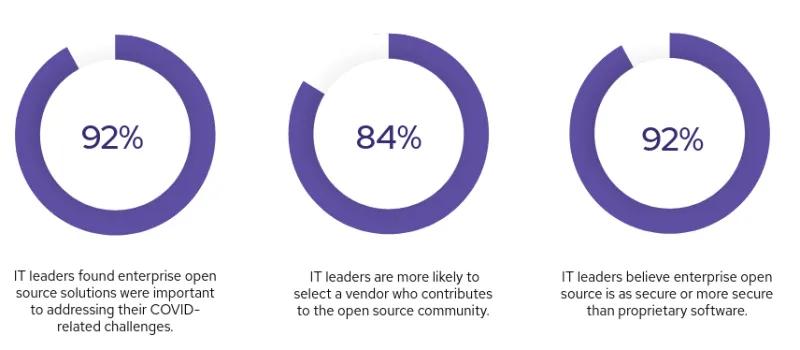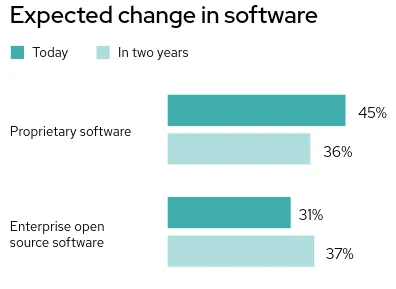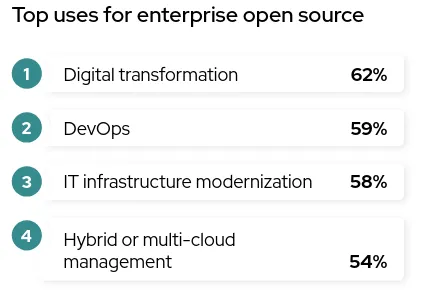Retail is an incredibly diverse landscape of industries around the world. It can range from franchise operations to small shops selling essential food and supplies to multinational corporations manufacturing and selling products with global brand awareness. Some sectors of the industry are well known for making high profits from small volumes, but for the majority of retail businesses, profit margins are small and becoming even smaller.
Given this background of low margins, limited budgets and the complexity of IT systems required to keep their businesses operating, many retailers understandably rely on open source software to keep their IT systems running. The advantages are well known— open source software is easy to consume, works well and is often perceived to be available at a low cost.
Why then, should retail businesses pay attention to enterprise open source software? Surely, that comes with a cost?
Red Hat’s fourth annual The State of Enterprise Open Source report highlights how organizations across many different sectors are turning toward enterprise open source to help deliver their IT functions.
“What we found as we embarked on our fourth annual The State of Enterprise Open Source: A Red Hat Report is that not only is the open source development model showing no signs of slowing down, it has actually accelerated during the pandemic.” Paul Cormier, Chairman, Red Hat
The report is based on interviews with 1,296 IT leaders from 14 countries, exploring the use of enterprise open source software. Respondents stated they have influence over the purchasing decisions within their organization (in app development, app infrastructure, cloud, storage, middleware, server OS or virtualization) and were not informed that Red Hat was the sponsor of the survey. Respondents also needed to be familiar with enterprise open source and have at least 1% Linux installed at their organizations.
The results are clear. IT leaders believe that enterprise open source software provides an improved security posture and is generally of higher quality than proprietary offerings, both of which are key factors in their decision-making process. Cost is still a consideration, but it’s not the only consideration for IT leaders when investigating enterprise open source software. This is reinforced by the finding that 95% of respondents said that enterprise open source is important to their organization’s overall enterprise infrastructure.
Key findings for the retail industry
With 90 retail sector IT leaders from 14 countries included in the respondents, further analysis of the key findings from the retail industry in The State of Enterprise Open Source: Retail provides some interesting insights into the retail industry.
Globally, retail went through a metamorphosis during the recent COVID pandemic, so it's interesting to see that 92% of IT leaders found that enterprise open source solutions were important in addressing their COVID-related challenges.
Bolstering the security of IT systems while also protecting customer data have become key requirements for any retail organization. The report highlights this with 92% of IT leaders believing that enterprise open source software is as secure or more secure than proprietary software.

Why is enterprise open source important to retail?
The retail industry is ever-changing. With decreasing profit margins, rapidly increasing costs and more complex supply chains, retailers are constantly looking for ways to better serve their customers.
When striving for business innovation with next-generation technologies and continuous improvement, enterprise open source solutions can often make the difference to a retail customer. From the report, 78% of IT leaders expect to increase their use of enterprise open source software for emerging technologies.
IT leaders are increasingly switching from proprietary software to enterprise open source software. In two years' time, these IT leaders expect to reduce their use of proprietary software from 45% to 36% while increasing their use of enterprise open source software from 31% to 37%. This represents a dramatic shift from proprietary software to enterprise open source software.

These figures indicate that retail IT leaders are using more enterprise open source software to help drive innovation within their business while also keeping control of their IT costs.
How do these findings shape the retail industry?
For most industries covered by the report, infrastructure modernization usually takes the top position when IT leaders are asked how they use enterprise open source software and solutions within their organizations. This suggests many industries are still replacing their proprietary software and hardware. However, in the retail industry, digital transformation takes the top spot with 62%, closely followed by DevOps and IT infrastructure modernization with 59% and 58% respectively.

With the top three uses for enterprise open source software being digital transformation, DevOps and infrastructure modernization, it’s reasonable to conclude that IT leaders in the retail industry are focused on improving their infrastructure while striving to deliver better services and features to their own customers.
How can the retail industry benefit from enterprise open source?
What does this mean to retailers? How are they really using enterprise open source to improve their business? The simplest way to answer this question is with a real example.
It is common for brick-and-mortar retail locations to have a number of servers sitting in the back room of the store to manage local IT functions. Their use is wide and varied and can range from stock movements to the store and colleague work rotas to recording refrigeration maintenance records.
For security reasons, many stores will also have security cameras recording video feeds to a permanent data store. This system would be separate from the local store servers.
What could be achieved if the two were combined in some way? In addition to recording the video feeds, an AI system running on the local IT servers could also analyze the video feeds looking for activity such as:
- Abandoned shopping carts or restocking cages blocking aisles and obstructing customers.
- A build up of customers at checkout points, generating an automatic alert to suggest that another register should be opened.
- Customers running in the store, or other unusual activity, which may indicate an issue that should be investigated.
To analyze in real time, the video processing would have to take place in the store since the latency and network bandwidth involved in sending the video feed off-site for processing and then returning an alert to trigger some action would take too long.
There are proprietary solutions available, but the cost of putting them in every store could be prohibitive. This is where enterprise open source has a part to play. If you consider the components required to make the solution work, they could include:
- A machine learning component to view video feeds and create a model identifying the event the retailer is looking for such as blocked isles, queue build up and running customers.
- A well-defined model that identifies the true events but doesn’t trigger against a similar but unmatched event.
- A mechanism to distribute the model to every store.
- Analysis of the video feeds in store using the model to identify the triggered event.
- Distribution or alerting on the triggered event to notify colleagues to take some action.
Every one of these components could be provided using enterprise open source software from a variety of suppliers including Red Hat.
Not only is enterprise open source software more cost-effective, it also provides a continuous conduit to the evolution of the technologies deployed in collaboration with other enterprises across the ecosystem in the open source community. Global retailers tend to have a multitude of hardware and operating platforms which can be better accommodated with enterprise open source solutions. It provides the freedom of choice for the best of breed technologies without any constraints with a single proprietary provider. Usage of enterprise open source also serves as a catalyst for collaborating on platforms that can provide this as a service to the industry at large.
Summary
Retailers need to differentiate themselves by delivering better quality services and functions to their customers, associates and the business. To do so, they need to have the freedom of choice to continuously innovate the in-store experience for their customers with cost-effective options. Having access to the emerging technologies that define the platforms of tomorrow is fundamental to making this a reality. Enterprise Open Source technologies provide options that are more effective and resilient to that end than their proprietary or open source equivalents.
Learn more
- The State of Enterprise Open Source: A Red Hat report
- The State of Enterprise Open Source: Retail (infographic)
- 7 reference architecture designs for retailers
- OpenShift Data Science workshop: Object detection for retail
- Change is inevitable – you need to be ready
- Digital transformation: 5 principles for the retail industry
About the author
As a Chief Architect for Retail in the UK, Boyle engages in strategic dialog with IT decision makers and influencers across the ecosystem of Red Hat customers and partners. Boyle collaborates with architects and technologists across the globe to unlock the potential of open source solutions.
More like this
Accelerating success with the Red Hat Partner Program
Smarter troubleshooting with the new MCP server for Red Hat Enterprise Linux (now in developer preview)
Technically Speaking | Build a production-ready AI toolbox
AI Is Changing The Threat Landscape | Compiler
Browse by channel
Automation
The latest on IT automation for tech, teams, and environments
Artificial intelligence
Updates on the platforms that free customers to run AI workloads anywhere
Open hybrid cloud
Explore how we build a more flexible future with hybrid cloud
Security
The latest on how we reduce risks across environments and technologies
Edge computing
Updates on the platforms that simplify operations at the edge
Infrastructure
The latest on the world’s leading enterprise Linux platform
Applications
Inside our solutions to the toughest application challenges
Virtualization
The future of enterprise virtualization for your workloads on-premise or across clouds
